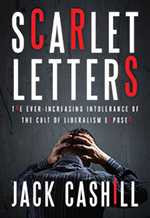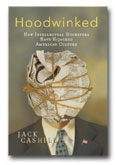Better to Reign in KC Than Serve in Heaven?
Jack Cashill's newest book will be out August 4th:
“Scarlet Letters: The Ever-Increasing Intolerance of the Cult of Liberalism Exposed"
![]()
© Jack Cashill
Published in Ingramsonline.com - April 2015
Another year, another proposal to improve public education in Kansas City—and another set of disappointments.
A few years back, I had the occasion to speak to a group of inmates at a high-security California prison. The meeting was going well until the candy delivery came in. Everything crunched to a halt as these otherwise grown men got down to the deadly serious business of divvying up the candy bars among themselves. I dared not distract them. I recall that moment when I read about recent developments in the Kansas City Missouri School District.
The district is back in the news again. Inevitably, as in any honest article about the district, the news is not good. The news is not even news. Reading newspaper coverage of the various battles is like watching the History Channel’s many replays of World War II: Educational perhaps, but we all know how it turns out. And what they are fighting about is not the future of the free world, but the disposition of a dwindling supply of academic candy bars.
The battleground in question is a charter school, Academie Lafayette. Of the 24 people who rated the school at greatschools.org, 24 gave it five out of five stars. “An excellent charter school in the heart of Kansas City,” wrote one parent. “This French-immersion school is a reason to stay in KC and raise a family.”
“Amazing, amazing school!” wrote another (presumably) parent. “Stayed in the city because of Academie Lafayette and couldn’t be more happy.” Added a former student, “I feel incredibly blessed to have been exposed to so many different world views because of the diverse staff. When I was there, I was lucky to be a part of a student body that was also incredibly diverse—racially and socioeconomically.”
The problem for some people is that the one-third minority Academie Lafayette is not diverse enough. Despite its success—or perhaps because of it—the school’s effort to partner with the Kansas City district to create a charter high school along similar lines has met with furious resistance.
Among the leaders of the opposition is a fellow named Clinton Adams. If my history is correct, Adams arrived in the site of what is now Kansas City in 1821 with Francois Chouteau. While Chouteau was setting up his trading post, Adams established something called the Urban Summit’s education committee, which he still chairs.
In all seriousness, Adams has been doing this for a long, long time. Some years back, Ingram’s named him to our “Power Elite” under the rubric, borrowed from Milton’s Paradise Lost, “better to reign in hell than serve in heaven.” He seemed to like it.
A proposed site for a Lafayette-style high school would be the current Southwest High, whose recent incarnations have done little but depress property values in the city’s otherwise charming southwest corridor. Clinton rejects that plan as “elitist.” He added, “I would hope people want academic excellence and an integrated education system throughout the city.”
Ain’t gonna happen. For those new to town, Kansas City has been spending megabucks for excellence “throughout the city” since at least 1977. That year, Jimmy Carter appointed a good old boy from southwest Missouri, Russell Clark by name, to the federal bench. The newly minted judge decided the federal government would run Kansas City schools until their students reached the national median on test scores. By that logic, the feds would run half of America’s schools forever, but logic was never Clark’s strong suit.
Clark’s plan was to desegregate the district by attracting white students from the suburbs. He would attract these students with shiny new schools and programs. When Kansas City citizens swooned at the $2 billion price tag, Clark unilaterally doubled taxes on Kansas City property owners and raised the payroll taxes on its work force.
Clark also levied a huge assessment against the state of Missouri and laun-ched the biggest one-man building project since Ramses II, including the construction of 17 new schools and the rehabilitation of 55 old ones.
Although Academie Lafayette is exactly the kind of school Clark hoped to create, it is the opposite of what his Soviet-style, top-down planning produced. A more typical fruit of that planning was Central High, a school that then-Sen. John Ashcroft described as “a gold-plated Taj Mahal.”
The dazzling new schools like Central, despite their swimming pools and planetariums, did not draw. To understand why, forget about what Mayor Sly James today calls people’s “uncomfortable feelings with race.” Listen instead to the parents and community members at Central High who voiced their feelings at greatschools.org:
“As a parent I must say I never seen such disarray, secrecy and disrespect for any child and parent. My son and I have had the roughest time trying to get the school to comply with their own rules that we have virtually given up.”
(Note: For your convenience, I’m just going to sic the entire following paragraph:)
“I’ve been to this school and it is bad kids takeing drugs teachers not caring about the kids ive seen some teachers watch some figts and not even brake it up then when the cops came they would go back in the room like nothing happened.”
“I have found the school to be disorganized and chaotic. I have had great difficulty in finding the appropriate resource to help my child obtain information needed for higher education.”
These reviews have not been cherry-picked. There are no good reviews for Central. These reviews speak to the problem that nary a public official has dared to address in all the years I have been here, namely that when fatherless children reach a critical mass, they will subvert all conventional models of public schooling.
After 20 years of ruling the Kansas City district like McArthur ruled Japan, Clark came to pretty much the same conclusion. When I interviewed him in Springfield shortly after he stepped down from the bench, he said as much. Too many fatherless children, he came to see. Too little motivation at home.
“I don’t know,” he mused, “if the disparity (between black and white students) can ever be eliminated. Probably not.”
The elimination of disparity was what absolutely riveted those prisoners when the candy arrived. At the end of the squabble, everyone got his, but they were all still in prison.
Time to find a loftier goal.





